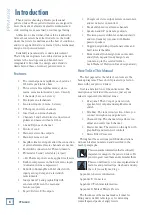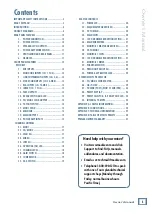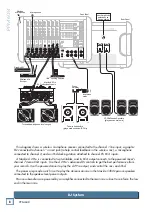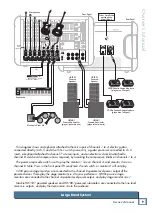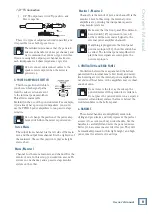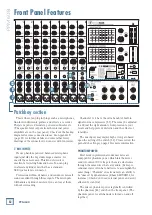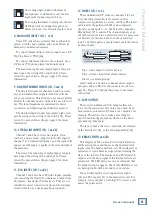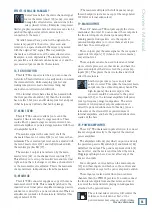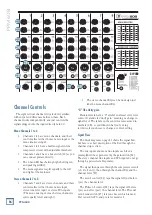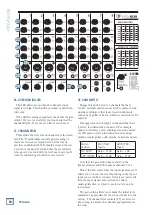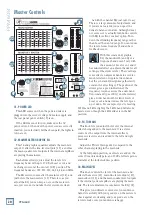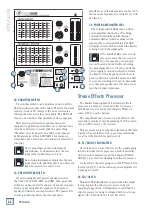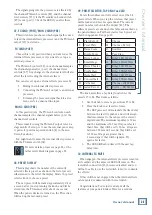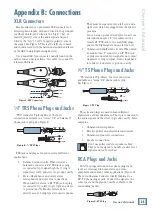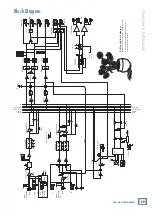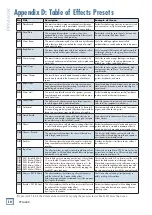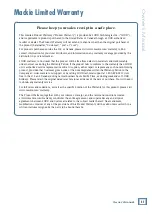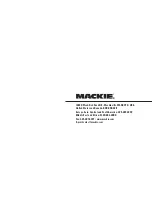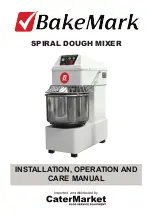
17
Owner’s Manual
Owner’
s Manual
21. MON 1
This control allows you set up a nice monitor mix,
independent of the main mix or the monitor 2 mix.
Adjust these controls on each channel until your band is
happy with the stage monitor mix. The controls are off
when turned fully down, deliver unity gain at the center
detent, and can provide up to 15 dB of gain turned fully
up. Adjustments to the channel level or main mix level
will not affect the monitor output, but channel EQ and
gain [28] will.
One of the powered mixer's internal amplifiers can
power passive stage monitors if you set the power amp
mode switch [4] on the rear panel. Mon 1 send [17] is a
line-level output if you want to connect external power
amplifiers and passive stage monitors, or powered stage
monitors.
22. FX/MON 2
These controls allow you to send a sample of each
channel's signal to the internal FX processor, and to
the FX/mon 2 line-level output [15] to run external
processors, or a second set of stage monitors.
Carefully adjust each control to set up the FX or
monitor 2 mix. The controls are off when turned fully
down, deliver unity gain at the center detent, and can
provide up to 15 dB of gain turned fully up.
The dual nature of this knob (FX or mon 2) is
determined by the setting of the FX send /mon 2 send
switch [47]. More FX/mon 2 details are shown on page
14 and page 23 (item 47).
CHANNEL EQUALIZATION (EQ)
The PPM608 channels have 3-band equalization: low
shelving, mid peaking, and high shelving. It’s probably
all the EQ you’ll ever need! Shelving means that the
circuitry boosts or cuts all frequencies past the
specified frequency. For example, the low EQ boosts
bass frequencies below 80 Hz and continues down to the
lowest note you never heard. Peaking means that
certain frequencies form a “hill” around the center
frequency.
With too much EQ, you can really upset
things. We’ve designed a lot of boost and cut
into each equalizer circuit because we know
that everyone will occasionally need that. But
if you max the EQ on every channel, you’ll get mix mush.
Equalize subtly and use the left sides of the knobs
(cut), as well as the right (boost). If you find yourself
repeatedly using full boost or cut, consider altering the
sound source, such as placing a mic differently, trying a
different kind of mic, changing the strings, or gargling.
23. HIGH EQ
The high EQ provides up to
15 dB of boost or cut above
12 kHz, and is flat at the center
detent. Use it to add sizzle to
cymbals, an overall sense of
transparency, or an edge to
keyboards, vocals, guitar and bacon frying. Turn it down
a little to reduce sibilance or to mask tape hiss.
24. MID EQ
The mid EQ provides up to
15 dB of boost or cut at
2.5 kHz, and is flat at the center
detent. Midrange EQ is often
thought of as the most dynamic,
because the frequencies that
define any particular sound are
almost always found in this range. You can create many
interesting and useful EQ changes by turning this knob
down, as well as up.
25. LOW EQ
The low EQ provides up to
15 dB of boost or cut below
80 Hz. The circuit is flat (no
boost or cut) at the center
detent position. This frequency
represents the punch in bass
drums, bass guitar, fat synth
patches, and some really serious male singers who eat
raw beef for breakfast.
20
Hz
100
Hz
1k
Hz
10k
Hz
20k
Hz
–15
–10
–5
0
+5
+10
+15
20
Hz
100
Hz
1k
Hz
10k
Hz
20k
Hz
–15
–10
–5
0
+5
+10
+15
20
Hz
100
Hz
1k
Hz
10k
Hz
20k
Hz
–15
–10
–5
0
+5
+10
+15


